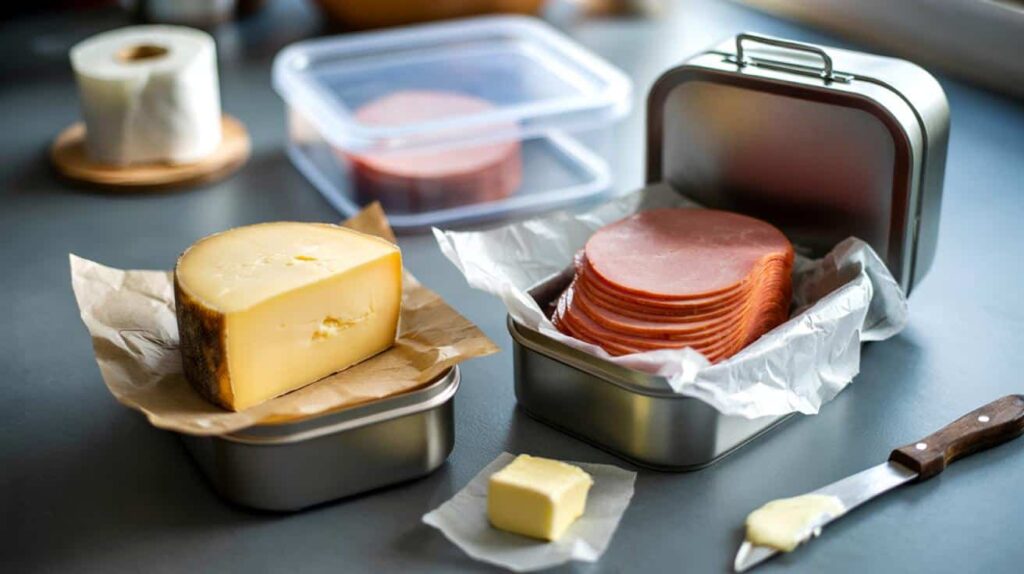With a few clever strategies, your slices and wedges will maintain their quality for a longer time.
Once the seal is broken, time begins to affect texture and aroma. You can slow this process with breathable wraps, a quick butter application, and improved refrigerator practices. Nothing complicated. Just practical kitchen sense that is effective.
Why ham and cheese deteriorate quickly
Oxygen interacts with fat and quickly diminishes flavor. Moisture accumulates on cold surfaces and promotes mold growth. Temperature fluctuations in a frequently opened fridge accelerate both of these issues. Salted meats and aged cheeses experience these changes the most once they are sliced or cut.
Air and excess moisture are the two main factors that can dry out, stale, or sour opened charcuterie and cheese.
The no-plastic strategy
Wraps that allow airflow, not suffocate
For sliced ham, waxed butcher paper is ideal. It limits surface moisture while allowing the meat to breathe slightly. Cling film traps moisture against the fat and often makes the edges sticky. If you can’t find butcher paper, parchment can be used with an additional outer layer for support.
For cheese, cheese paper or parchment manages moisture exchange better than film. The aim is to allow gentle airflow without causing dryness. Wrap it snugly, but not too tight. Leave space around the cut edge to prevent rinds from pressing into the paste.
Opt for waxed butcher paper for ham and parchment or cheese paper for wedges. Breathable wraps help maintain texture.
Butter barrier for the cut surface of cheese
Apply a thin layer of butter on the freshly cut surface. This lipid barrier minimizes air contact and slows down surface mold growth. Reapply after each serving. It is most effective on semi-hard and hard cheeses, such as Comté, Manchego, and Cheddar.
Paper towel to control moisture
Place a clean paper towel at the bottom of a container. It absorbs moisture and keeps surfaces dry. Change it when it becomes damp. This small action helps limit the microclimate that encourages spoilage.
Glass jars and tins over plastic containers
Use airtight glass or metal containers sized appropriately for the portion. Excess space can lead to drying. A snug container helps stabilize humidity and prevents strong odors. Glass does not retain smells or stain, and its seal maintains consistency.
- Wrap ham in waxed butcher paper; place in a small glass container.
- Butter the cut surface of cheese; wrap in parchment or cheese paper.
- Include a dry paper towel under the wrap to absorb moisture.
- Label the date and type to monitor shelf life.
Fridge placement that truly helps
Store opened ham and cheese between 2 °C and 6 °C. Avoid the fridge door. That area tends to get warm every time it opens. A middle shelf or produce drawer provides a more stable temperature. Consistent cold slows oxidation and prevents fat from leaking.
Freezing without remorse
Freezing helps prevent waste with ham. Freeze portions flat so they thaw quickly and evenly. Remove excess air, then wrap tightly and add a second layer. Cheeses vary in their freezing capabilities. Soft cheeses often lose their creaminess after freezing. Hard cheeses fare better in the cold, especially when grated or cut into blocks.
Thaw in the refrigerator, not on the counter. Allow ham or cheese to reach room temperature for 20–30 minutes before serving. Warmer fat releases aromas and feels tender on the palate.
Thaw in the fridge, then let sit at room temperature. Flavor develops as the fat softens.
Warning signs you shouldn’t ignore
On hard cheeses, a small area of fuzzy white or green mold can be salvaged. Cut a generous margin around and beneath it. On aged ham, a fine white bloom can be wiped away if the smell remains pleasant. Strong ammonia, rancid fat, or sour odors indicate a problem. In such cases, it’s best to discard it.
How long does it last once opened?
| Product | Best storage method | Fridge life after opening | Freezer option |
|---|---|---|---|
| Sliced ham (vacuum pack, opened) | Waxed butcher paper in small glass container | 5–10 days if wrapped properly | Yes, up to 2 months, well wrapped |
| Hard cheese (e.g., Parmesan, Cheddar) | Butter on cut surface + parchment/cheese paper | Several weeks with proper wrapping | Yes, better grated or in blocks |
| Semi-soft cheese (e.g., Gruyère, Gouda) | Butter method + parchment/cheese paper | 1–3 weeks depending on humidity | Possible, texture may change |
| Soft cheese (e.g., Brie, Camembert) | Original wrap plus parchment if necessary | 3–7 days once cut | Not ideal, often becomes grainy |
Small tools that make a significant impact
A thin, sharp knife provides clean cuts and exposes less surface to air. A good roll of parchment or cheese paper is worth having on hand. Glass containers with tight lids ensure a reliable seal. A simple fridge thermometer shows you the actual temperature, not just the dial reading.
Common mistakes that dry food out quickly
- Wrapping hot items directly from the counter. Allow the surface to cool before wrapping to prevent trapped steam.
- Using oversized containers. Extra air accelerates drying.
- Storing near the fan. Cold airflow dries out edges.
- Neglecting to label dates. You may lose track and miss flavor peaks.
Zero-waste strategies for tired pieces
Don’t discard a wedge that seems a bit dry. Melt it into a quick sauce or stir it into a risotto. Grate hard rinds into stocks for added flavor. Sliced ham that feels slightly leathery can still shine when folded into a tortilla, a quiche, or fried rice. Heating softens texture and releases fat-soluble aromas.
Serving tips and safety
Take both ham and cheese out of the fridge ahead of time. Twenty minutes significantly enhances flavor. Use a clean board and knife to prevent cross-contamination. Rewrap with fresh paper after serving. Change the paper towel if it feels damp.
A final guideline to avoid headaches: if the smell is reminiscent of ammonia or rancid fat, it’s best to discard it. Flavor never recovers after that point.








